Fixtures for the bathroom: types and selection

The choice of lighting for the bathroom must be approached thoroughly. In such rooms, there are often no windows, and therefore it is necessary to provide the space with an optimal light flux. Consider the key points of using lamps for bathrooms and help you decide on their choice.
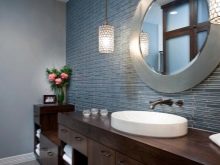
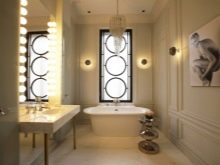

Primary requirements
Bathroom conditions differ from the rest of the dwelling. It is not only dark here, but also damp, and often ventilation has not yet been thought out. Condensation is inevitable, the temperature is constantly changing, leaks from the apartment on top are not excluded. Therefore, bathroom fixtures must comply with certain requirements.
The most important requirement is considered their protection from moisture. Products must be safe to operate. They are distinguished by the tightness of the closed-type housing, which prevents moisture from entering the contacts. These devices are equipped with special elements that prevent water from getting inside.


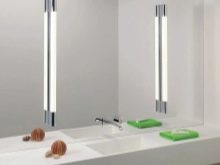
These products have a special marking, which indicates the degree of moisture protection. The higher the indicated number, the higher the protection class.
For example, a zero value indicates a lack of moisture resistance. Indicators 1 and 2 indicate low protection: in fact, such devices are protected only from vertically falling drops of water.

Indicator 3 indicates that the device is protected against splashes falling at an angle. The class 4 and 5 variants are not afraid of water jets. Products marked with 6 are considered the most suitable for use in bathrooms. Well-chosen devices do not flash or burn out for a long time.
Such products must meet increased safety, practical and economic requirements. In addition, the luminaires must be resistant to deformation and corrosion. The type of light source is also important. The luminous flux should be pleasing to the eye and sufficient for the volume of a particular room.
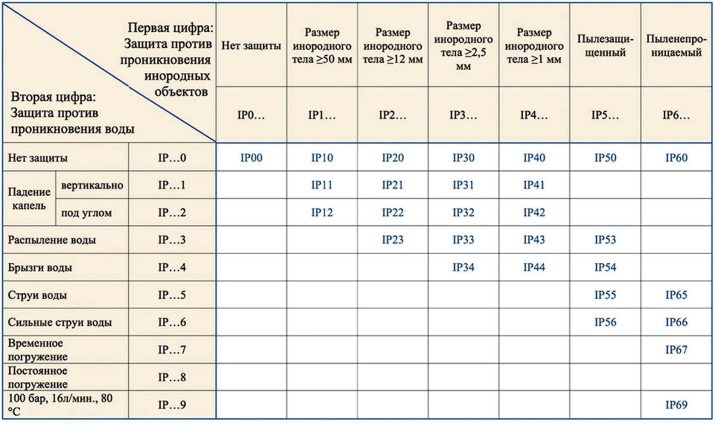
Bathroom fixtures differ in the type of installation and the type of lamps used. They cannot be mounted directly above open showers and bathtubs.... In so-called wet areas, low-voltage versions with a degree of protection of at least IP67 can be used. At a distance of 30-60 cm from the boundaries of wet zones, it is allowed to install devices with a protection class of at least IP45. In other zones, it is allowed to install luminaires with moisture protection IP24 and higher.
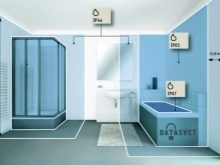

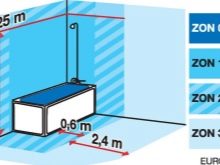
Varieties
The range of bathroom fixtures is varied. From a wide range of products for bathroom lighting, products for the ceiling and walls are in great consumer demand. Each type of model has its own characteristics and design differences. In this case, the products can be standard and built-in.
The design features of the models are different. Modifications are stationary or rotary... Products of the first type cannot be adjusted, the latter have a fixed base with a dynamic outer part. If desired, it can be turned in different directions or in a circle.
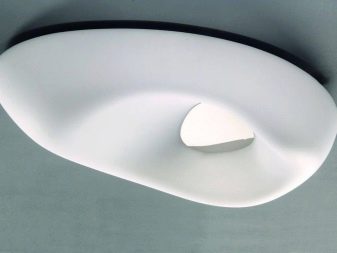
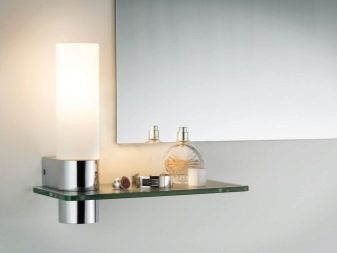

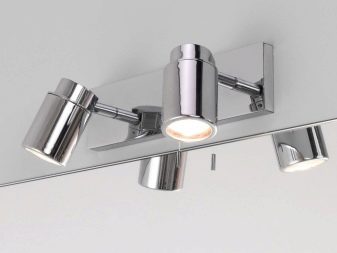
The ability to adjust is considered a very useful option for ceiling and wall lighting. You can direct the luminous flux to any functional area of the bathroom: on the closet, dressing table, sink, bath, niche with shelves, shower. Such lighting devices are used to accentuate any details of the bathroom interior. For example, they can highlight colorful panels on the walls, as well as accessories (flowerpots, floral compositions, figurines).
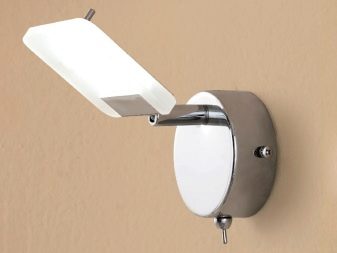
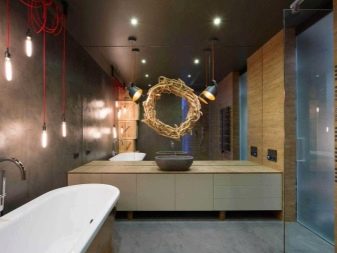
The disadvantage of stationary models is the directional light. Since it falls at a certain point, lighting devices have to be mounted in groups in order to effectively distribute light.
Most often they are placed in work areas of bathrooms. At the same time, the area of a particular room is taken into account (the larger it is, the greater the number of lamps).
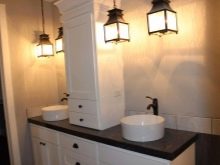

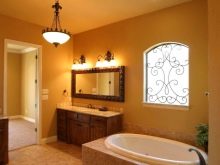
Ceiling
Ceiling-type lighting fixtures form the basis of central lighting of sanitary units. As a rule, these are lamps with closed waterproof shades or spot lighting. They are not only practical, but also variable in design and shapes. This allows you to equip a bathroom with an emphasis on the attributes of a particular interior style.
Products can be surface-mounted, suspended or built-in. Each type has its own characteristics. Most often, in the bathrooms of our country, there are options of the first or third type. They are located at the highest possible height and are suitable for installation in rooms with low ceilings.
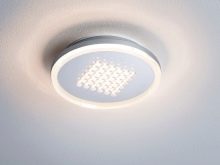

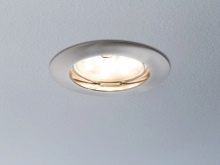
Suspended models used in spacious bathrooms of country residences, adapted for living rooms. They are used in rooms with high ceilings. These models are more decorative, but it is not always possible to call them the safest.... They are fixed in those places where moisture will not get on them.
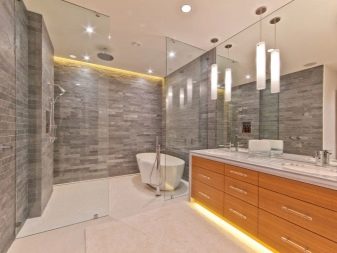
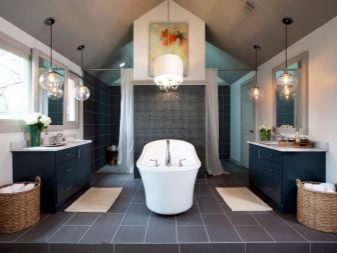
The built-in options are considered the ideal solution. Spot lighting consists of a set of identical small sized luminaires with a directional luminous flux. They are fastened with an equal pitch along the perimeter of the ceiling so that there are no dark corners in the room. Products consume a minimum of energy, converting it into light of a different shade.
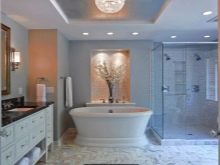
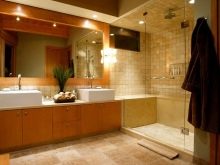
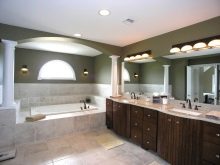
The original version of the built-in bathroom lighting is LED Strip Light. It is mounted either directly under the stretch film or behind the ceiling box molding. Although it is moisture resistant, the border protects it from splashing water as well.
Both tape and spotlights can be used as zoned ceiling lighting. They can accentuate the areas of the mirror, dressing table, mark the boundaries of the bath. In this case, it is necessary to take into account the type of light rays. For example, cold fluorescent lamps distort skin color, making it difficult to apply makeup correctly.
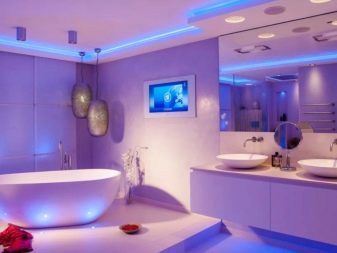
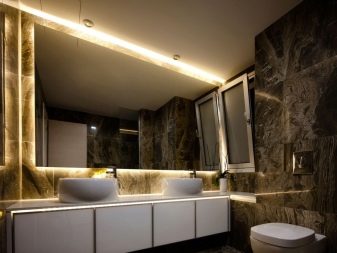
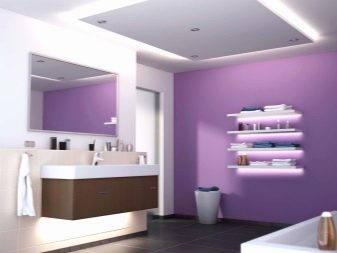
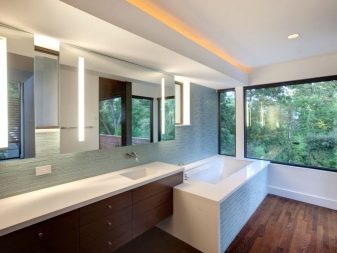
Wall mounted
Luminaires on the wall can be very diverse both in terms of mounting, and in the choice of shapes, as well as design. They may be built-in or overhead, large or compact, laconic or pretentious, modern or with a touch of antiquity. Models are divided into point options and wall sconces.

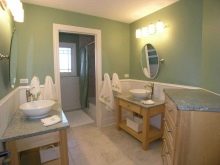

Spot lighting of this type usually follows the design of the ceiling. In this case, lighting devices can be mounted not only into the wall, but also into mirrors, and even into shelves with niches... Surface (surface-mounted) type devices are considered to be simpler in terms of installation and connection. With their help, the areas of washing, dressing, dressing table are illuminated.
These varieties are easy to maintain and care for.... They not only illuminate the space, but also zone it, highlighting one or two functional areas of a particular bathroom. Unlike ceiling-panel models, on the walls, options with floor lamps or spots with an adjustable angle of inclination of the light flux are more often attached.
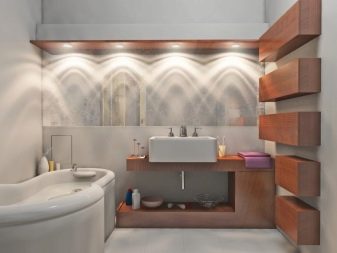
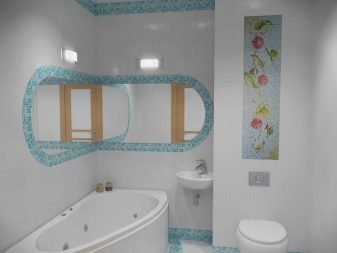
Wall sconces can be mounted horizontally and vertically. Install such lighting devices on the sides of the mirror, symmetrically between two mirrors. In addition, they are also placed on adjacent walls, if otherwise it is not possible to highlight individual functional areas.
The number of lamps on one sconce varies from 1 to 5. In this case, options with a large number of small shades are mounted, as a rule, above the mirror.
These models are also water resistant, according to the type of light sources used, they are halogen and LED. In small bathrooms, wall lighting can replace ceiling lighting.
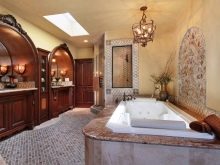
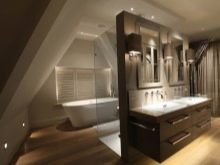
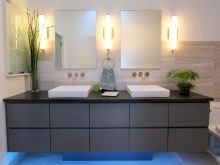
Floor and table
Depending on the interior design, it can be supplemented with floor lighting, which can be mobile or built-in. Products of the first type are nothing more than floor lamps, which are installed in relatively dry areas of the bathroom. The built-in lighting of the bathroom is represented by spotlights installed in the floor cladding.
The built-in options are very convenient, they are not afraid of water splashes, they allow you to accentuate the area of washing, washing or changing clothes. Moreover, such lighting is often part of the combined lighting of bathrooms. Such spotlights are built in flush with the tiles, placing them with the same pitch according to the selected light composition.
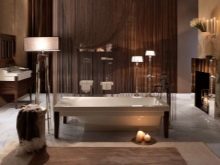
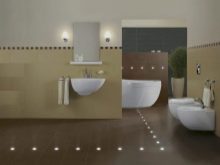
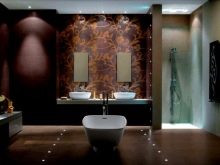
Table lamps are needed mainly to compensate for the lack of illumination of dressing tables. As a rule, products of this type are used in large bathrooms adapted for living quarters. Such lamps are not only functional elements of the interior, but also its decor. Their design is selected taking into account the overall lighting concept of the space.
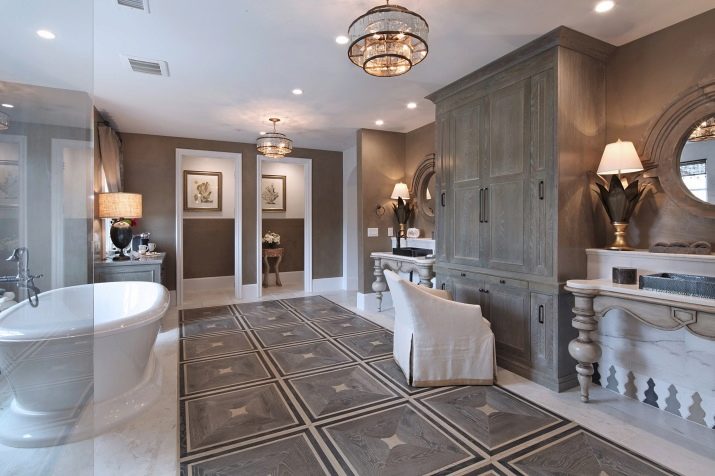
Lamp power and luminous flux
According to the International System of Units (SI), illumination is measured in lux. Their number for a particular room should be at least 200. When making calculations, take into account the ratio of lux to lumen (1: 1) or luminous flux falling on 1 sq. m of area (1 lux = 1lm / m2). To make it easier to understand, you can translate lumens to watts. For example, power:
- a 230 V (42 W) halogen incandescent lamp equals 900 lumens;
- induction 40 W - 2800 lm;
- LED 230 V (10 W) - 860 lm;
- LEDs about 60 W - up to 6000 lm.
The illumination level of energy-saving lamps is 4-6 W per 1 sq. M. For halogen lamps it is higher, ranging from 10 to 20 W per 1 sq. M, for incandescent lamps - about 20-30 W per 1 sq. M. When choosing the type of lighting, the color scheme of the room is also taken into account. For example, if it is bright, minimal lighting is sufficient.In dark rooms, the illumination should be more intense.
It is better to use 12 V low-voltage appliances in the bathroom.... You need to buy waterproof options for wet rooms. During the installation process, they must be powered through an RCD or a differential machine. You can take those that are designed for 220 V. In addition to the aesthetics of appearance, they do not need the cost of transformers.

The average illumination of bathrooms per 1 m2 is 50 lm. However, this figure can be adjusted depending on the height of the ceiling in a particular room. For example, if the ceiling height is up to 2.7 m, the illumination is left unadjusted. When it is higher and reaches 3 m, it is multiplied by the ceiling height factor equal to 1.2.
If the ceiling in the bathroom is high and is about 3.5-4 m, the coefficient reaches 2. The formula for calculating the power looks like this: bathroom area * illumination rate * additional factor (S m2 x 50 x 1.2).
The calculation method determines the number of lamps and their type.
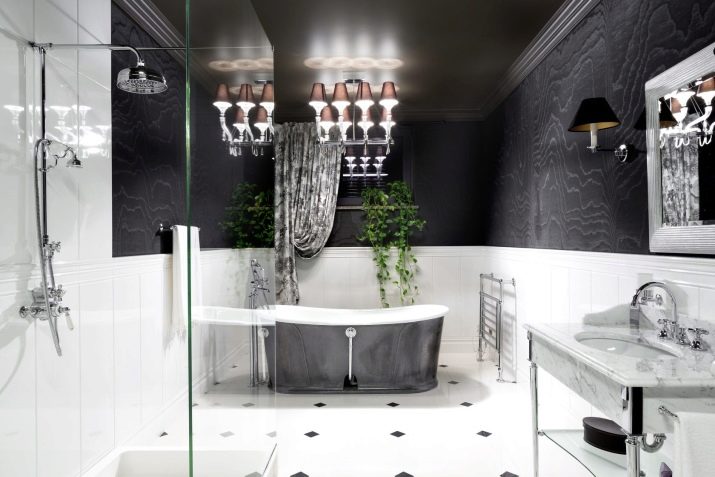
Choose between incandescent, halogen, energy saving and LED lamps. The first varieties are considered obsolete today. They consume too much energy and become hot during operation. Their main disadvantage is the fear of moisture: when it gets in, they simply burst.
Halogen lamps consume less electricity and differ in budgetary cost. Along with this, they are too sensitive to voltage surges. Energy-saving light sources are characterized by low electrical energy consumption. However, they require special disposal conditions.
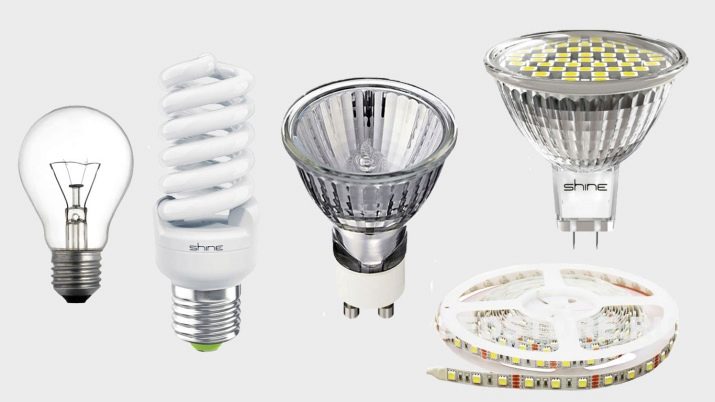
Of all types of lamps the choice of LED products is considered the best solution. Unlike other modifications, LEDs have a wide range of luminous flux shades. Depending on the choice of the product class, you can illuminate the bathroom not only with standard neutral, warm or cold tones of the luminous flux. RGB models allow you to change the tone of the light from dark blue to purple, red, yellow, pink and green.
The intensity of the luminous flux is selected based on the size of the room. Users should be comfortable inside the room. It is undesirable to use lamps with light sources that give off yellowness, or models with too cold radiation.
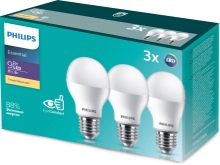
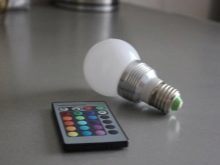
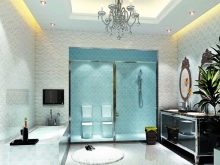
Top brands
Among the wide range of manufacturers of bathroom lighting fixtures, several leading brands are worth mentioning, whose products are in great consumer demand.
- Arte lamp Is an Italian company engaged in the production of lighting products. It supplies products to more than 20 countries of the world, is distinguished by a strict approach to quality and a wide range of design solutions for the manufactured lamps.

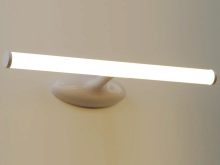

- Eglo Is an Austrian brand founded in the 60s of the last century. It supplies to the lighting equipment market a wide range of waterproof luminaires made of high-tech materials. It makes modifications to modern forms and design solutions.
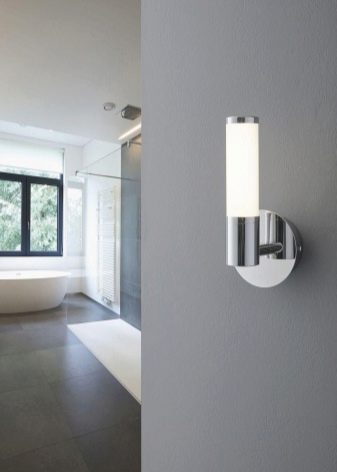
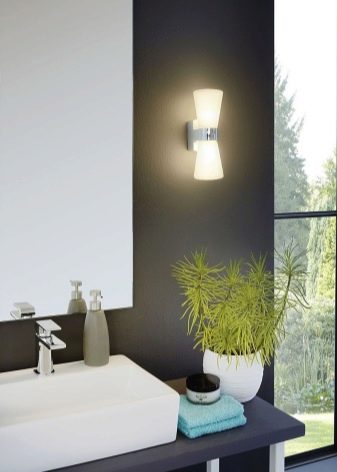
- MarksLojd - a leader in the production of lighting fixtures from Sweden. A manufacturer that stands out from its competitors in its approach to the design of its assortment. In its lines there are models for every taste: from laconic and simple to the most sophisticated.
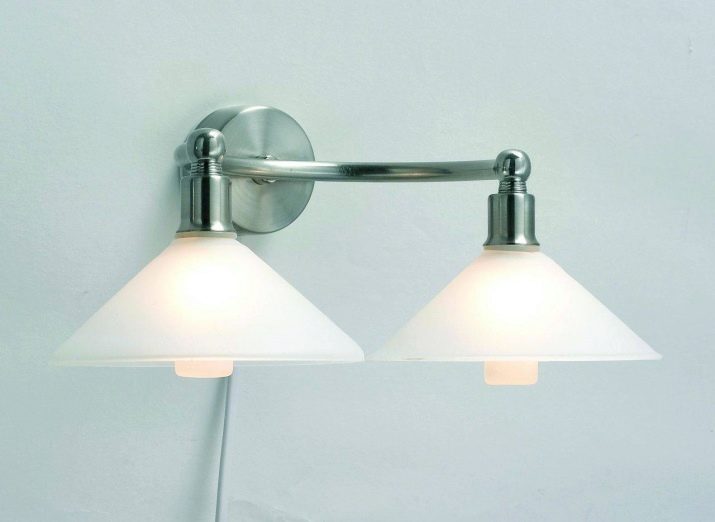
- Massive - a Belgian manufacturer of lighting fixtures for various fields of use. Produces lighting fixtures for luxurious interior compositions and models for classic bathrooms in typical city apartments. His lines include not only sconces and spots, but also luxurious waterproof chandeliers.
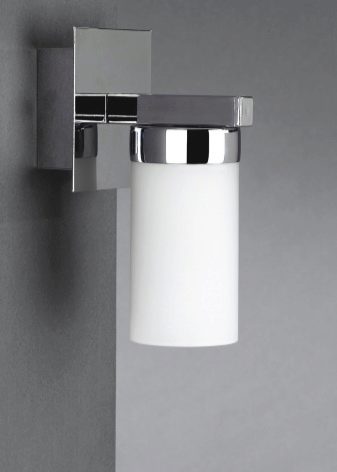
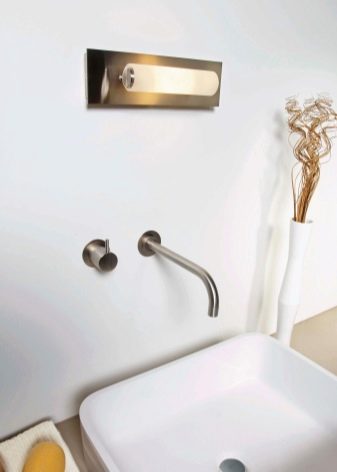
- IKEA - a well-known manufacturer with a worldwide reputation, supplying the market with lighting devices in various design and stylistic solutions. Differs in an optimal ratio of price and quality, has a wide range of buyers of different status.
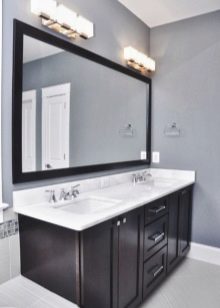
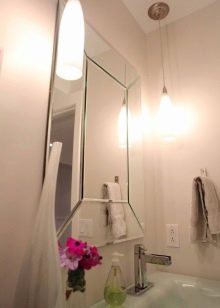
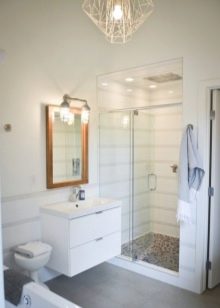
How to choose?
The choice of bathroom fixtures depends on various factors. If the ceilings are low, it is better to choose compact overhead or recessed structures. At the same time, they look at the style of the interior: the best options for lighting the ceiling will be light panels, spotlights and tape. Walls can be decorated with compact spots by placing them above the mirror. For spacious bathrooms with high ceilings, suspension fixtures are acceptable.
When buying, you need to pay attention to the presence of rubber seals at the junction of the plafond with the base of the device. In addition, you need to look if there are moisture-proof plugs at the entrance to the case. It is important to pay attention to Passport products, where the belonging of the luminaire to waterproof models is indicated.
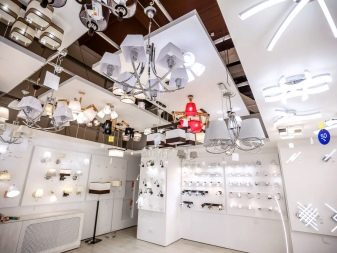

When choosing one or another option, take into account the size, design, shape and purpose of the product. Luminaires are not only functional, but also decorative elements of the interior. They must fit into the style of a particular room, correspond to its status. You need to buy models with a water resistance class of at least 4-5. In addition, the dustproof index must be taken into account.
The dimensions of the lamps are selected based on the parameters of the bathrooms themselves. For example, spotlights and spots, compact ceiling panels are appropriate for small rooms. Sconces in small rooms are also chosen compact.
Products on hangers are suitable for spacious rooms. The number of shades of such lamps should be at least three. If the room has partitions, it is worth illuminating each functional area.
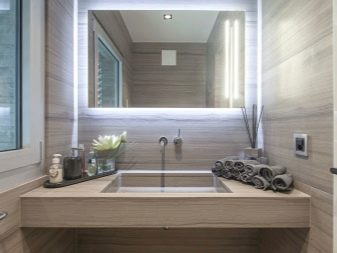
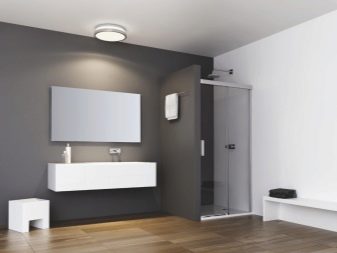


Lighting recommendations
The location and number of fixtures in the bathroom depends on various factors. These include:
- dimensions of a particular room;
- bathroom ceiling height;
- the presence of partitions or protrusions;
- the need for a visual expansion of space;
- the need to highlight separate functional areas;
- support for the unity of the interior style.

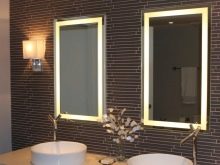
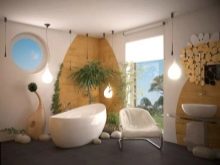
The simplest is to organize the lighting of a small bathroom without partitions and wall protrusions.... As a rule, one central luminaire or several spotlights located at an equal pitch is sufficient here. In this case, moisture-resistant lighting devices can be built-in or overhead. If necessary, ceiling lighting is enhanced by auxiliary lighting in the wash area (above the mirror or on both sides of it).
For example, for an area of 4-5 square meters, you need to buy one ceiling lamp. In this case, it is necessary to purchase a product with the ability to install at least two lamps.
At the stage of conducting electricity, you need to take care of additional lighting of the washing area.
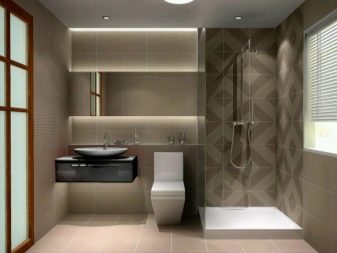

Small rooms need compact models with optimal power. Chandeliers in such rooms are not bought: if they can also be used in large bathrooms adapted for living rooms, then in bathrooms with low ceilings and a lack of usable space, they are completely out of place. Models with a diameter of about 30 cm are needed here.
If additional lighting is needed, buy wall lighting devices... These can be overhead models, sconces or spots. They are installed at a height of at least 2 m from the floor. According to generally accepted requirements, their light should not hit the eyes. The side mirror illumination is mounted at a height of 1.6 m.
The shape of the shades can be round, spherical or flask-shaped. The power of the auxiliary light should be lower than that of the main light.
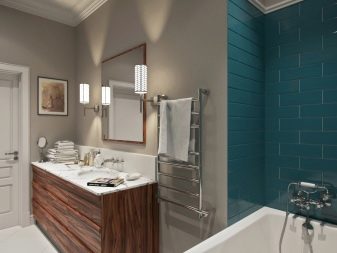

As for outdoor decorative lighting, its power usually does not exceed 5 watts. Individual luminaires can be installed in the floor of shower cabins, around the bathtub and even in the tile joints of the floor covering. This creates a special atmosphere in the bathroom that is conducive to relaxation.
It is a little more difficult to place lamps in rooms with partitions.For example, in combined bathrooms with partitions, there is a need to illuminate each separate functional area. In this case, the degree of illumination intensity may vary. Usually, the most illuminated place in this case is the mirror area. This will make it easier to apply makeup, shave, and create hairstyles.
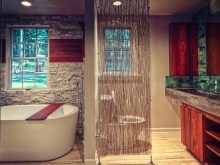
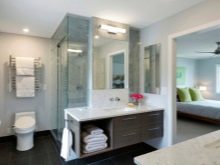
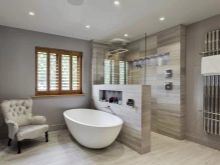
As for decorative lighting, it shouldn't be too bright. This type of lighting means the designation of any element of the interior (niche, shelf, cabinet, bath bowl, panel). You can simulate a window by decorating part of one of the walls with a waterproof lightbox. Such lighting devices have a flat surface on which a thematic image is applied.
Optionally, you can decorate the wall with light panels depicting a window, sea views, cityscapes. If you like to accentuate the space with light stripes, you can choose them. In addition, the luminous flux color may differ from the auxiliary lighting.
However, in any case, the placement and calculation of the number of luminaires is carried out correctly, based on the requirements for a particular room.
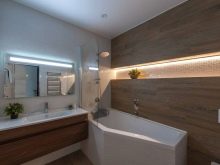
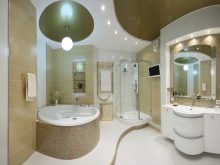
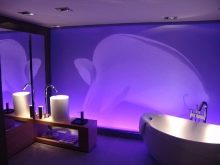
Successful examples in the interior
We offer 10 examples of a harmonious solution in the organization of bathroom lighting:
- a selection of lamps for the washbasin in a modern design;
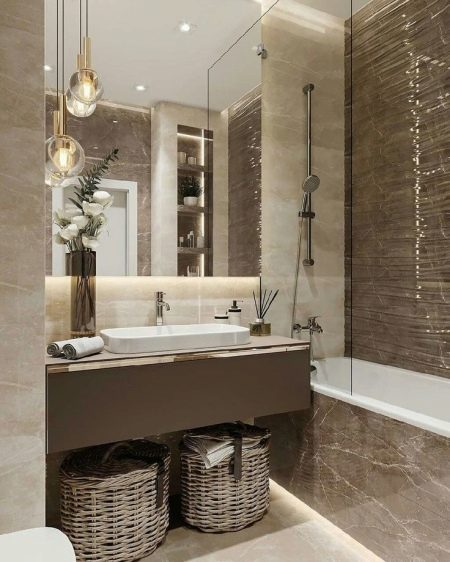
- combination of ceiling and wall lighting in a combined bathroom;
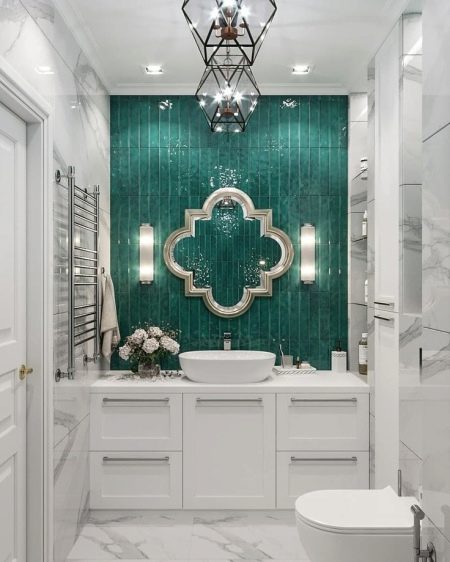
- overhead lighting devices in the interior of an ethnic bathroom;
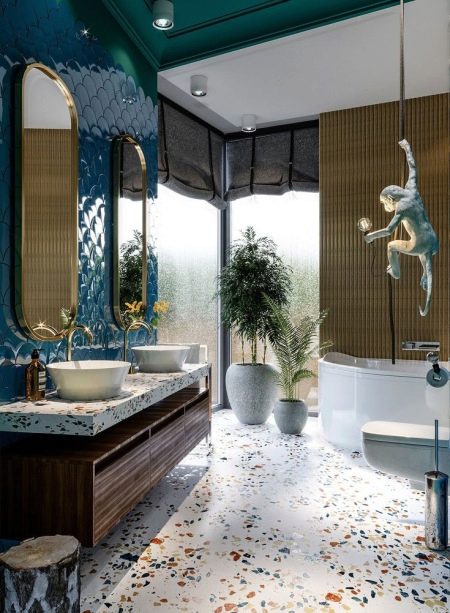
- a combination of spherical and ribbon ceiling lamps;
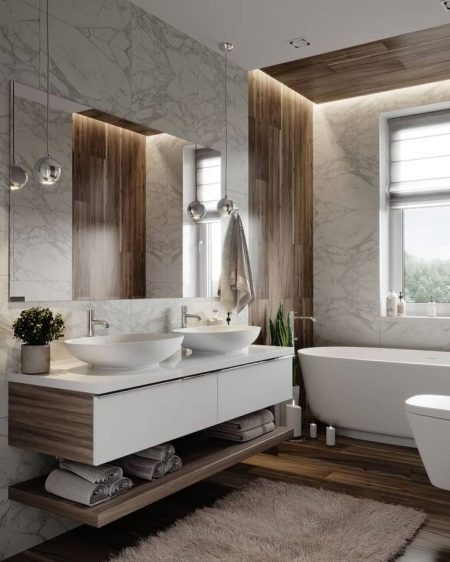
- choice of hanging lighting to accentuate the washbasin area;
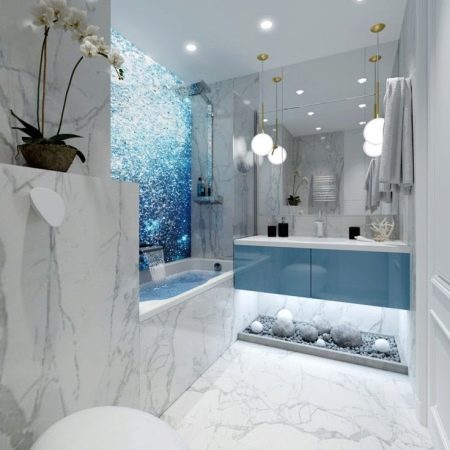
- decorating the space with hidden LED strip-type lighting;
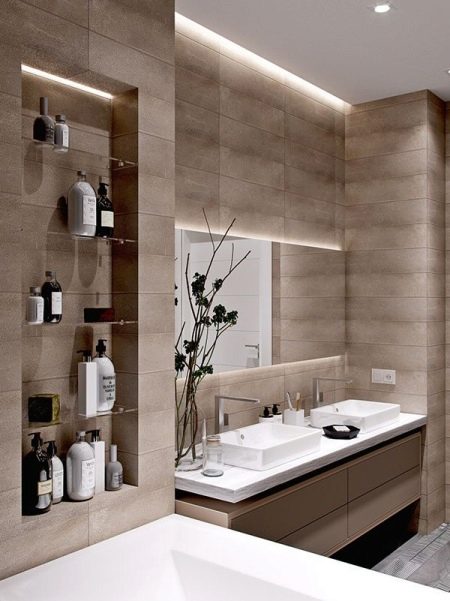
- lighting of the washing area, selected taking into account the peculiarities of the plasterboard ceiling structure;
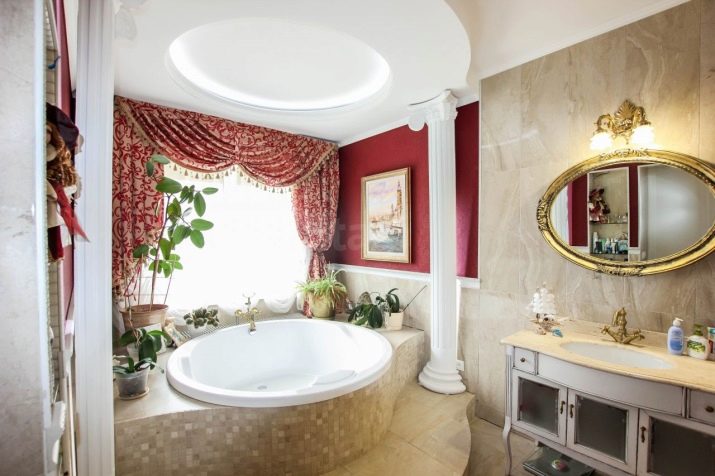
- decoration of the washbasin area with horizontal lamps located above the mirror;

- installation of lighting under a stretch film, creating the effect of twinkling stars;
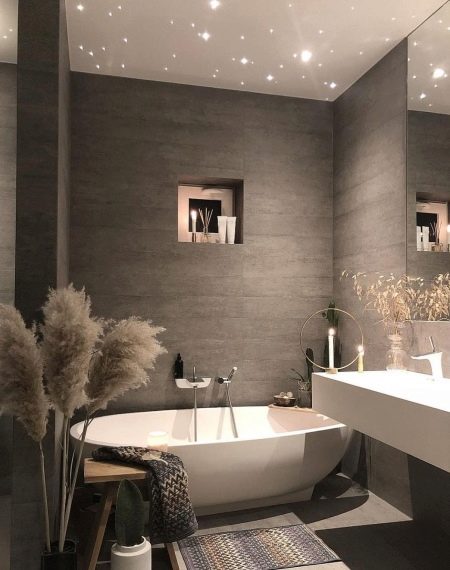
- the choice of lighting in the form of balls on suspensions, suitable for the interior in neutral tones.
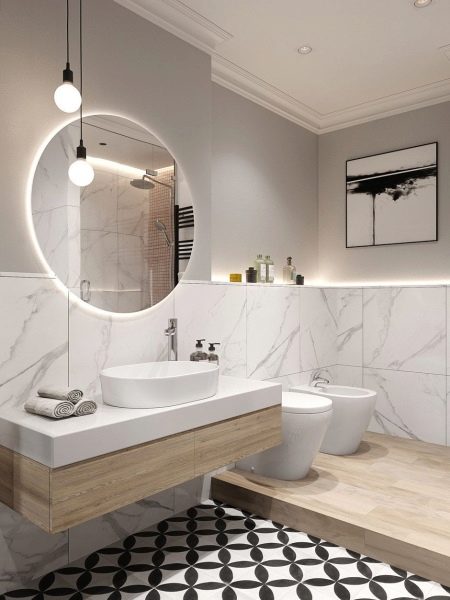
How to choose a lamp for the bathroom, see below.








